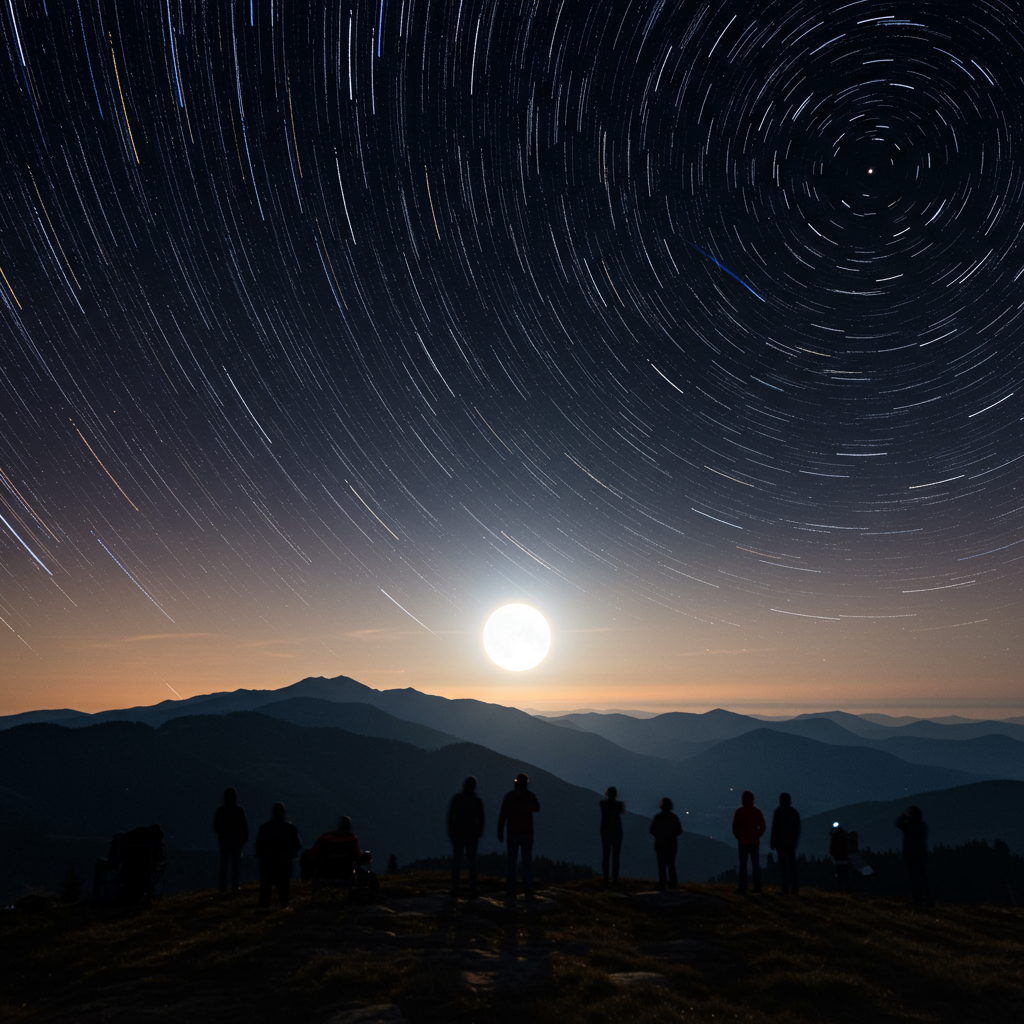Prepare for an unforgettable journey through the night sky as October 2025 unfolds a spectacular array of celestial wonders. This month promises an exceptional lineup for stargazers, featuring rare comet appearances, the year’s first Supermoon, and prime opportunities to catch dazzling meteor showers under dark skies. Whether you’re a seasoned astronomer or a curious beginner, this comprehensive guide will illuminate every must-see event, equipping you with the knowledge and tips to maximize your skywatching experience.
Comets Take Center Stage: A Trio of Bright Visitors
October 2025 is truly special for comet enthusiasts, with three prominent comets gracing our skies. These icy wanderers, often elusive, offer a unique chance for observation, some even with simple binoculars.
Comet C/2025 K1 (ATLAS)
Mark your calendars for October 8, when Comet C/2025 K1 (ATLAS) reaches perihelion, its closest point to the Sun. Expected to shine at a magnitude of 5.2, this comet should be visible through binoculars. Observers in the Northern Hemisphere will find optimal viewing in the morning sky, while those in the Southern Hemisphere can spot it during both morning and evening hours. Its trajectory makes it an excellent early-month target.
Comet C/2025 R2 (SWAN)
Discovered just in September, Comet C/2025 R2 (SWAN) makes its closest approach to Earth on October 20. At a mere 0.26 AU (astronomical units) away, this comet currently boasts a magnitude of 7. Under exceptionally dark skies, it might even become visible to the naked eye around this date. Southern Hemisphere stargazers will have the best vantage point, though northern observers might catch it low in the evening sky by mid-October. This presents an exciting opportunity for dedicated skywatchers.
Comet C/2025 A6 (Lemmon)
Just a day later, on October 21, Comet C/2025 A6 (Lemmon) passes closest to Earth at 0.6 AU. It’s anticipated to reach magnitude 8, making it a binoculars-only target initially. However, optimistic forecasts suggest it could brighten considerably, potentially reaching magnitude 3 by its perihelion on November 8, transforming it into an easy naked-eye object. A truly unique highlight for photographers occurs on October 19: Comets SWAN and Lemmon will be simultaneously visible, separated by a wide 80 degrees, offering a captivating “double treat” in the night sky.
Lunar Spectacles: Supermoon and Dark Sky Blessings
The Moon orchestrates several key events this October, from a prominent Supermoon to providing ideal conditions for meteor showers. These lunar phases profoundly influence how we perceive the cosmos.
The Harvest Supermoon
On October 7 at 03:48 GMT, the Full Moon will grace our skies as the Harvest Moon and the first Supermoon of 2025. This designation means it’s near its perigee (closest point to Earth) and coincides with the autumnal equinox period, making it appear approximately 6.6% larger and 13% brighter than an average Full Moon. While the size difference is subtle to the naked eye, the Harvest Moon is significant. It traditionally rises at nearly the same time for several consecutive evenings, a phenomenon that historically aided farmers working late. This supermoon also generates noticeably larger tides.
The New Moon and Dark Skies
The New Moon on October 21 at 12:25 GMT is a crucial event for deep-sky observations. This phase results in the darkest skies of the month, creating perfect conditions for observing fainter objects like the Orionid meteor shower and Comet Lemmon, which will both be peaking around this time. Without lunar glare, the true majesty of the cosmos is revealed.
Other Lunar Highlights
Throughout October, the Moon continues its dance with various celestial bodies. On October 19, the waning crescent Moon will make a close approach to Venus, creating a stunning visual. Just a few days later, on October 23, it aligns with Mercury and Mars. For observers in southern Argentina, Chile, and the Falkland Islands, a rare lunar occultation of Antares will occur on October 24-25, where the Moon passes directly in front of the reddish star. Closer to Earth, near the first quarter moon on October 28, optical illusions known as the Lunar X and Lunar V will be visible with binoculars and telescopes, peaking around 7 p.m. EDT. Finally, on October 31, the “Golden Handle” of Mare Imbrium will be illuminated, a dramatic sight as sunlight catches the Montes Jura mountains while the bay floor remains dark.
Dazzling Meteor Showers: Catch the Orionids!
Seven meteor showers will peak in October 2025, with one particularly promising for spectacular viewing. Meteor showers offer a mesmerizing display as Earth passes through trails of cosmic dust.
The Orionid Meteor Shower
The undisputed highlight is the Orionid meteor shower, peaking on October 21. Coinciding with the New Moon, this shower benefits from incredibly dark, moonless skies, offering optimal viewing conditions. Originating from the famed Halley’s Comet, the Orionids are known for their fast-moving, bright meteors, often leaving long, glowing trails. Observers can expect to see around 20 meteors per hour (ZHR) during its peak. To maximize your chances, find a dark location away from city lights, lie back, and allow your eyes at least 20-30 minutes to adjust to the darkness. Look towards the constellation of Orion after midnight.
Other October Meteor Showers
While the Orionids steal the show, other showers are also active:
October Camelopardalids: October 5
Draconids: Peaking October 8. Unfortunately, this coincides with the Full Moon, significantly hindering visibility. However, the Draconids are known for potential outbursts, so observers east of 40°E in the Northern Hemisphere might still catch something despite the moonlight.
Delta Aurigids: October 11
Southern Taurids: October 13, expected to produce a much lower rate of about five meteors per hour, further hampered by moonlight.
Epsilon Geminids: October 18
Leonis Minorids: October 24
Planetary Parade: Giants and Elusive Wanderers
October provides excellent viewing opportunities for some planets, while others require more effort or specialized equipment. Knowing where and when to look can transform your planetary observations.
Visible Planets
Mercury: This elusive inner planet will be challenging for most of October. However, it reaches its greatest eastern elongation on October 29 (23°54′ from the Sun), making it briefly visible low in the southwest after sunset. Observers in the Southern Hemisphere will have a higher, clearer view. Around October 20, Mercury will also pass just south of fainter Mars, a challenging but rewarding sight.
Venus: Shining brilliantly as the “Morning Star,” Venus will dominate the eastern predawn sky all month. Through a telescope, it appears as a waxing, nearly full phase.
Mars: Remaining close to the Sun and low in the southwest, Mars offers only brief glimpses in the twilight. Its distance makes it a less prominent target this month.
Jupiter: Becoming an excellent target, Jupiter will rise after midnight, brightening from magnitude -2.1 to -2.3. Visible to the naked eye, a pair of binoculars will reveal its four Galilean moons. Telescopes will further unveil its equatorial bands and potentially the Great Red Spot. Keep an eye out for frequent eclipses, occultations, and shadow transits of its moons.
Saturn: Having recently passed its opposition in September, Saturn remains exceptionally well-placed for observation. It will be visible throughout the evening and the first half of the night. Even a small telescope will reveal its extraordinary rings, which will be tightening their tilt from 1.5° to 0.6°, and possibly some of its larger moons.
Uranus: While requiring binoculars or a telescope, Uranus is visible from mid-evening onward. It will be slowly drifting retrograde through Taurus, appearing as a blue-green speck in binoculars.
Neptune: Like Uranus, Neptune demands binoculars or a telescope. It will continue to follow Saturn across the night sky, and large telescopes might even glimpse its moon, Triton.
Bonus Dwarf Planet: Ceres
On October 2, the dwarf planet Ceres reaches opposition, marking its closest and brightest appearance for the year at magnitude 7.5. Though not visible to the naked eye, it can be spotted with 8×40 or 10×50 binoculars in the constellation Cetus. This offers a rare opportunity to observe a dwarf planet in our solar system.
Essential Skywatching Tips for October 2025
To make the most of October’s celestial displays, a little preparation goes a long way.
Find Dark Skies: The biggest impact on visibility is light pollution. Head away from city lights to a rural location for the best views, especially for meteor showers and fainter comets.
Allow Eye Adjustment: Give your eyes at least 20-30 minutes to adapt to the dark. Avoid looking at bright phone screens during this time.
Check Local Times: While dates are provided, remember that specific event times (e.g., peak of a Supermoon or meteor shower) are often given in GMT. Always convert these to your local time zone to ensure you don’t miss anything.
Stay Informed About Weather: Clear skies are paramount. Consult local weather forecasts regularly to plan your viewing nights.
Use Astronomy Apps: Tools like the Sky Tonight app can provide real-time interactive sky maps, precise timings, and object locations tailored to your exact coordinates, making finding objects much easier.
Bring Equipment (Optional but Recommended): Binoculars are excellent for comets, some planets, and lunar details. A telescope opens up views of planetary features, distant galaxies like Andromeda, and the Moon’s intricate craters.
Patience is Key: Stargazing requires patience. Give yourself time to relax and let the wonders of the night sky unfold.
Frequently Asked Questions
What makes October 2025 an exceptional month for stargazing?
October 2025 stands out due to an unusual convergence of significant celestial events. It features the potential naked-eye visibility of three comets (ATLAS, SWAN, and Lemmon), including a unique “double treat” where SWAN and Lemmon are visible simultaneously. Additionally, the month hosts the first Supermoon of 2025 (the Harvest Moon), and most notably, the Orionid meteor shower peaks during a New Moon phase, ensuring exceptionally dark skies for optimal viewing. This combination of bright comets, a supermoon, and a major meteor shower under ideal conditions makes it particularly memorable.
What tools or preparations are recommended for observing celestial events in October?
For basic viewing, finding a location away from city lights is crucial. Allowing your eyes 20-30 minutes to adjust to the darkness will significantly enhance visibility. A pair of binoculars (e.g., 8×40 or 10×50) is highly recommended for spotting comets, observing brighter planets like Jupiter and Saturn, and appreciating lunar details. For fainter objects like Uranus and Neptune, or detailed planetary features, a telescope is necessary. Utilizing a reliable astronomy app can help locate objects and provide precise local viewing times. Dressing warmly and bringing a comfortable chair or blanket will also improve your experience.
Which celestial event in October 2025 is easiest for beginners to spot without special equipment?
For beginners without special equipment, the Harvest Supermoon on October 7 will be the easiest and most visually striking event. As the year’s first Supermoon, it will appear slightly larger and brighter than an average Full Moon, requiring no optical aid. Additionally, bright planets like Venus (the Morning Star in the eastern sky) and Jupiter (rising after midnight) are easily visible to the naked eye throughout the month. While the Orionid meteor shower peaks with dark skies, it still requires patience and a dark location for the best experience.
Conclusion
October 2025 promises to be a truly spectacular month for anyone gazing upwards. From the rare opportunity to track multiple bright comets and witness the year’s first Supermoon, to catching the prolific Orionid meteor shower under moonless skies, the cosmos offers an unparalleled show. Planets like Jupiter and Saturn will also be prime targets, showcasing their magnificent features. Remember to seek out dark locations, allow your eyes to adjust, and use resources like astronomy apps to enhance your experience. This October, step outside, look up, and immerse yourself in the awe-inspiring beauty of our universe. It’s an unforgettable time to connect with the cosmos!



